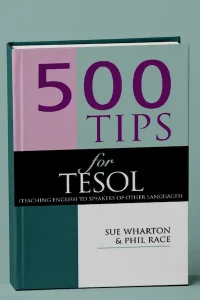500 Tips for TESOL Teachers that You are going like if you followed them. I hope that they are going to be useful.
500 Tips for TESOL Teachers
We have written this book for people who teach English to speakers of other languages, for people who are training to do so, and for people who work with trainee teachers. Although it is primarily intended for those nearer the beginning of their careers, it will also be of use to more experienced teachers who are moving into new areas, such as course design, self-access provision or teacher training. So, whether you are just starting your career or whether you have been teaching for a long time now, we hope you will find useful suggestions in our book.
Chapter 1, ‘Planning for teaching and learning’, starts by exploring the basis of successful learning processes. We look at the assessment of learners’ needs, from both a language learning and a more broadly human perspective, and then go on to look at planning a course and locating and designing suitable materials to support it.
Chapter 2, ‘Meeting learners’ needs’, looks in more depth at language learners as social human beings. We consider how to foster valuable learning processes in the classroom, and offer practical tips on how to handle large groups and smaller groups. We also make suggestions on how best to support mature learners, and learners away from home. We end with a discussion of ways of collecting useful feedback from the learners themselves.
Chapter 3 is the most substantial part of this book and deals with a range of language teaching activities. We look first at techniques for teaching the various aspects of language, and end with some ideas about creative things, such as games and role plays, that can contribute to the learning of a wide range of content and skills. Chapter 4 is about using flexible or self-access learning in your work, or even to replace well-chosen aspects of your normal face-to-face provision. We look at the establishment of self-access facilities, their use, and the choice and design of materials to go in them.
Chapter 5 offers suggestions on ways of making use of information and communications technologies to support ESOL learning. The use of e-mail and computer conferencing can be particularly useful to people learning a language, giving them practice in a non-threatening environment, both at reading and writing in their target language.
Chapter 6 is about assessment, including helping learners to benefit from self-assessment and peer-assessment. The chapter includes suggestions for helping learners to prepare successfully for public examinations.
Chapter 7 is written for you! We include various suggestions from which to choose your own personal professional development activities, and also some ‘survival’ suggestions, which we hope will prove useful to you if and when they are needed.
This is not a book to be read straight through from start to finish. We suggest that you scan the book to find out what is most directly relevant to you at any given time, and start from there. If you are an experienced teacher, we know that you may already be implementing, or exceeding, many of the suggestions we offer; but we hope that you will still find ideas that you had not considered before, and which you can adapt to your own teaching. If you are a new teacher, we realize that not all of our suggestions may be immediately relevant to you; we hope that you will take those that you need now (Chapter 3 might be a good place to start), and come back later to some of the others. Then if you are training teachers, we hope that these sets of tips will be useful springboards to discussion in training sessions or reminders afterwards.
At the end of the book we include suggestions for further reading for all of the chapters. These books and articles will help you to look in much more detail at all of the areas which we have touched on in this book. We’ve chosen titles that we feel will be accessible to less experienced teachers, but which will also provide more experienced colleagues with food for thought.

